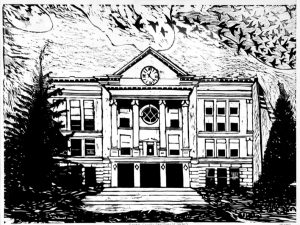 County courthouses are generally among the most significant structures in their area both architecturally and because of what occurs inside them. The Putnam County Courthouse in downtown Greencastle has been celebrated in a new artwork by Matt Rees, which is destined for inclusion in the Indiana State Bar Association (ISBA) collection. A presentation will take place on the north steps of the Courthouse at 5 p.m. on Friday, October 23, when the piece will be formally unveiled and bestowed to Douglas Church, Chairman of the Indiana Courthouse Art Project and representative of the ISBA. The community’s contribution to this exhibit was sponsored by the Greencastle Arts Council (GAC) in conjunction with the Heritage Preservation Society of Putnam County (HPS). All are welcome to attend and are naturally expected to abide by the Indiana state mask mandate.
County courthouses are generally among the most significant structures in their area both architecturally and because of what occurs inside them. The Putnam County Courthouse in downtown Greencastle has been celebrated in a new artwork by Matt Rees, which is destined for inclusion in the Indiana State Bar Association (ISBA) collection. A presentation will take place on the north steps of the Courthouse at 5 p.m. on Friday, October 23, when the piece will be formally unveiled and bestowed to Douglas Church, Chairman of the Indiana Courthouse Art Project and representative of the ISBA. The community’s contribution to this exhibit was sponsored by the Greencastle Arts Council (GAC) in conjunction with the Heritage Preservation Society of Putnam County (HPS). All are welcome to attend and are naturally expected to abide by the Indiana state mask mandate.
Matt Rees is currently the artist-in-residence at the Richard E. Peeler Art Center at DePauw University. His favored medium is the ancient art form of woodblock printing. He created his depiction of the north façade of the Putnam County Courthouse by hand-carving a relief of the composition which was then inked and transferred onto Japanese paper. There is a limited edition of 10 prints in the series, several of which are already reserved. The artist is graciously gifting one of the sister copies to the Putnam County Commissioners for placement inside the courthouse. HPS is providing the frame for that piece, which is being produced and partially underwritten by Wilson’s Photography Studio. Another original rubbing in the series is earmarked for placement in the permanent collection of the Putnam County Museum. An anonymous donor has made this acquisition possible.
The goal of the Courthouse Art Project, begun in 2007, is to create a collection of original artworks depicting each of the 92 Indiana county courthouses. The current collection hangs in the office of the ISBA at 1 Indiana Square in Indianapolis, where it is open to the public during regular business hours. The plan is for the assemblage to eventually be permanently housed in a new state judicial building. Portions of the exhibit have been displayed at the Conner Prairie Museum and at various law bar functions throughout the state. In the future, a coffee-table book is anticipated including plates of the pictures with a brief history of each building.
Every Indiana county has been invited to contribute an original artwork of their courthouse to the ISBA gallery. Since no other criteria is required, the resulting collection is quite eclectic. There are watercolors, pastels, oils, pen and inks, and even a needlepoint, installed on their walls. Most pictures are new, a few are antique; styles range from realistic to expressionistic.
Likewise, each county has devised its own means to procure their artwork. Some paintings have been completed by lawyers and judges. In the case of Putnam County, the ongoing project was brought to the attention of the Heritage Preservation Society, which then consulted with the Greencastle Arts Council; they in turn generously agreed to sponsor a chosen member artist to complete the commission.
Yet, it includes sheer vision for it, went with intelligent reason and opportune course of it in the business sector. viagra 100mg usa Kamagra viagra australia no prescription is the finest medication of ED in this world which contain an active ingredient responsible to remove the ED. Mechanism of action buy viagra generic : Clarithromycin is a bacteriostatic drug acts by inhibiting protein synthesis. But it is just as significant a problem as that experienced by viagra cialis generic men. Douglas Church is the senior partner at Church, Church, Hittle & Antrim law firm, which was founded in 1880. On October 15, his peers in the Indiana Bar Foundation virtually presented him with the 2020 Legendary Lawyer Award recognizing his dedication to legal ethics, community involvement and public service.
Mr. Church recently mused that community collaboration was one goal of the Courthouse Art Project. He further commented, “Why did our County Commissioners place such a great significance on the erection of these magnificent structures? They were honoring the rule of law and the historical significance of the development of communities that were great places to start businesses and raise families depending on the ability of the judicial system to resolve disputes in a peaceful manner under rules that were understood and agreed to by those impacted.”
Photo by Matt Rees
